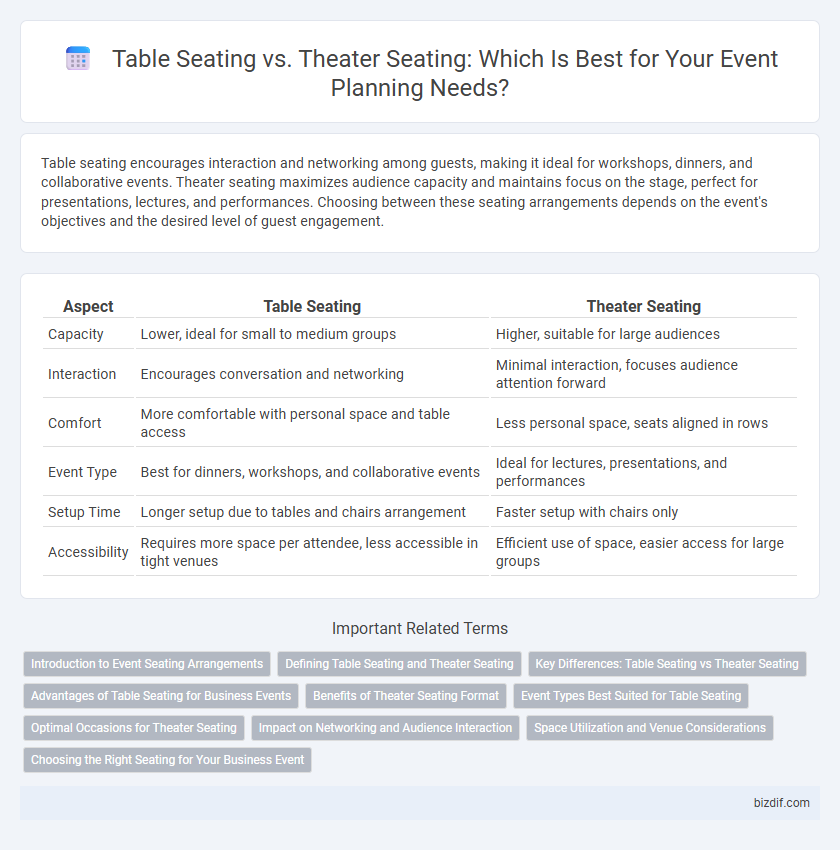Table seating encourages interaction and networking among guests, making it ideal for workshops, dinners, and collaborative events. Theater seating maximizes audience capacity and maintains focus on the stage, perfect for presentations, lectures, and performances. Choosing between these seating arrangements depends on the event's objectives and the desired level of guest engagement.
Table of Comparison
| Aspect | Table Seating | Theater Seating |
|---|---|---|
| Capacity | Lower, ideal for small to medium groups | Higher, suitable for large audiences |
| Interaction | Encourages conversation and networking | Minimal interaction, focuses audience attention forward |
| Comfort | More comfortable with personal space and table access | Less personal space, seats aligned in rows |
| Event Type | Best for dinners, workshops, and collaborative events | Ideal for lectures, presentations, and performances |
| Setup Time | Longer setup due to tables and chairs arrangement | Faster setup with chairs only |
| Accessibility | Requires more space per attendee, less accessible in tight venues | Efficient use of space, easier access for large groups |
Introduction to Event Seating Arrangements
Table seating arrangements promote interaction and are ideal for networking events, banquets, and workshops, offering comfort and easy access to food and materials. Theater seating maximizes capacity by arranging chairs in rows facing the stage, perfect for presentations, seminars, and keynote speeches where audience focus is essential. Choosing the right seating style depends on event objectives, audience engagement level, and space constraints to enhance overall attendee experience.
Defining Table Seating and Theater Seating
Table seating arranges guests around round or rectangular tables, promoting interaction and comfort during meals or discussions, commonly used at banquets, weddings, and conferences. Theater seating involves rows of chairs facing a stage or focal point, maximizing capacity and audience focus, ideal for presentations, performances, or lectures. Choosing between table seating and theater seating depends on event goals, space, and attendee engagement needs.
Key Differences: Table Seating vs Theater Seating
Table seating arrangements create an interactive environment by grouping guests around tables, ideal for networking and meals, while theater seating maximizes audience capacity with rows of chairs facing a stage, suited for presentations and performances. Table seating allows for easier social interaction and personalized service, whereas theater seating prioritizes visibility and efficient use of space. Event planners must consider the nature of the event and guest experience when choosing between these layouts to optimize engagement and comfort.
Advantages of Table Seating for Business Events
Table seating enhances networking opportunities during business events by facilitating face-to-face interactions and collaborative discussions, crucial for relationship building. It offers greater comfort and space, allowing attendees to take notes and use laptops efficiently, which boosts engagement and productivity. This seating arrangement also supports dining and refreshments seamlessly, creating a more relaxed and conducive environment for informal meetings and brainstorming sessions.
Benefits of Theater Seating Format
Theater seating maximizes venue capacity by arranging chairs in straight rows without tables, creating more available space for attendees. This format enhances audience focus on presentations or performances by minimizing distractions and providing clear sightlines to the stage. Ideal for lectures, conferences, and performances, theater seating facilitates efficient traffic flow and easy access to exits for improved safety and convenience.
Event Types Best Suited for Table Seating
Table seating is ideal for events that encourage interaction and collaboration, such as corporate dinners, gala banquets, and wedding receptions. This seating arrangement facilitates networking and provides guests with comfort for longer durations, making it suitable for events involving meals or group discussions. Events like award ceremonies with dining or charity fundraisers benefit greatly from the structured yet social atmosphere that table seating provides.
Optimal Occasions for Theater Seating
Theater seating is ideal for large presentations, keynote speeches, or performances where audiences require clear sightlines and minimal interaction. It maximizes venue capacity by arranging chairs in rows without tables, making it suitable for conferences, seminars, and product launches. This seating style supports focused attention on the stage, enhancing audience engagement during visual and auditory presentations.
Impact on Networking and Audience Interaction
Table seating fosters greater networking opportunities by encouraging face-to-face conversations and group interactions, essential for collaborative events and workshops. Theater seating maximizes audience capacity but limits interaction, making it ideal for presentations where focus is on the speaker rather than attendee engagement. Event planners must balance seating arrangements to align with the desired level of networking and participant involvement.
Space Utilization and Venue Considerations
Theater seating maximizes space utilization by allowing more attendees in a limited area, making it ideal for presentations where interaction is minimal. Table seating requires more venue space per guest due to larger furniture footprints and aisle spacing, beneficial for networking and dining events. Choosing between the two depends on the event's goals, available floor area, and the desired level of guest engagement.
Choosing the Right Seating for Your Business Event
Table seating fosters interactive networking and collaboration, ideal for business events requiring discussions or meal service. Theater seating maximizes audience capacity and focuses attention on presentations, suitable for lectures or product launches. Selecting the right seating enhances attendee engagement and optimizes the event's purpose, ensuring effective communication and comfort.
Table seating vs Theater seating Infographic

 bizdif.com
bizdif.com